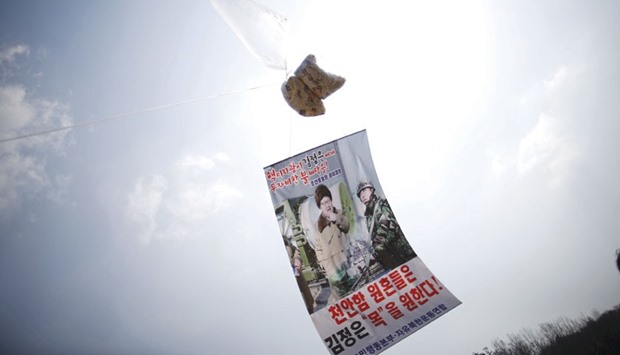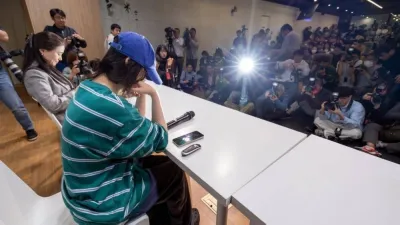
A balloon containing leaflets denouncing North Korean leader Kim Jong-Un is seen yesterday near the demilitarised zone separating the two Koreas in Paju, South Korea, on the sixth anniversary of the sunken naval ship Cheonan. The lettering on the banner reads ‘Merciless attacks on nuclear addict Kim Jong-Un’ (top) and ‘Sprits of deceased 46 navy sailors on the sunken naval ship Cheonan want Kim Jong-Un’s life’.
North Korea released a new propaganda video yesterday showing a nuclear strike on Washington and then threatened South Korea with a “merciless military strike” for slandering leader Kim Jong-Un.
Pyongyang has been ramping up the bellicose rhetoric and propaganda for weeks, since the launch of annual South Korea-US war games that it views as provocative rehearsals for invasion.
Seoul and Washington made the already large-scale joint drills bigger than ever this year in response to the North’s nuclear test in January and long-range rocket launch a month later.
Menacingly titled Last Chance, the video released yesterday shows a submarine-launched nuclear missile laying waste to Washington and concludes with the US flag in flames.
The four-minute video romps through the history of US-Korean relations and ends with a digitally manipulated sequence showing a missile surging through clouds, swerving back to Earth and slamming down in front of Washington’s Lincoln Memorial.
The US Capitol building explodes in the impact and a message flashes up on the screen in Korean: “If US imperialists budge an inch toward us, we will immediately hit them with nuclear (weapons).”
The North has issued similar videos in the past, including one in 2013 showing the White House in a sniper’s crosshairs and the Capitol building exploding in a fireball.
The latest offering was published on the North’s propaganda website DPRK Today and shows images from the Korean War, the capture of US spy ship Pueblo in 1968 and the first crisis over North Korea’s nuclear programme in the early 1990s.
North Korea has been pushing to acquire a submarine-launched ballistic missile (SLBM) capability which would take its nuclear strike threat to a new level, allowing deployment far beyond the Korean peninsula and the potential to retaliate in the event of a nuclear attack.
It has conducted a number of what it says were successful tests of an SLBM, but experts have questioned the claim, suggesting that Pyongyang had gone little further than a “pop-up” test from a submerged platform.
Tensions always rise on the Korean peninsula during the annual South-US military exercises, but have reached a particularly elevated level this year.
That is partly due to the nuclear test and the United Nations sanctions that followed, but also because of the first-time inclusion in the drills of an operation that envisages strikes to “decapitate” North Korea’s top leadership.
Pyongyang has taken that as a direct threat to leader Kim Jong-Un and responded with increasingly abusive personal attacks on South Korean President Park Geun-Hye.
On Thursday, Kim presided over a huge, long-range artillery drill simulating a strike on Park’s office and official residence in Seoul.
And yesterday the artillery section of the Korean People’s Army (KPA) issued an “ultimatum” demanding Park apologise and punish those who formulated the decapitation strategy.
“If matchless traitor Park Geun-Hye and her group do not respond ... the long-range artillery force of the KPA large combined unit on the front will move over to merciless military action,” it said in a statement carried by the North’s official KCNA news agency.
The warning came hours after KCNA published a statement by the North’s “reconciliation council” that referred to Park as “dog-like”, “chicken-like” and a “dirty old woman” who grants sexual favours to the leaders of South Korea’s allies.
The insults have multiplied as Park has hardened her stance with the North in recent months, accusing Kim of leading his country along a path of self-destruction and vowing harsh retaliation to any military provocations.
Yesterday South Korean activists launched three balloons carrying tens of thousands of anti-Pyongyang leaflets across the border into North Korea.
Defector-turned-activist Park Sang-Hak and his colleagues released 50,000 leaflets tied to three large balloons from an empty field near Paju City close to the border with North Korea, marking the sixth anniversary of the sinking of a South Korean warship with the loss of 46 sailors.
Seoul pinned the blame for the sinking on the North and froze trade and investment ties.
One of the three balloons was strung with a large banner printed with a Pyongyang-published picture of leader Kim Jong-Un smiling against the backdrop of a missile being assembled.
“Bring down a firestorm on nuclear maniac Kim Jong-Un”, read the slogan.
“We plan to launch a total of 10mn leaflets into the North over the next three months condemning North Korea’s nuclear tests,” Park told journalists.
In October 2014, North Korean frontier guards attempted to shoot down a set of such balloons, triggering a brief exchange of fire across the border.
Park and other activists face protests by residents and merchants living near the border, who are concerned that their livelihood might be affected.
Since North Korea’s fourth nuclear test on January 6, South Korea has resumed blasting a mix of K-pop and propaganda messages into the North, using giant banks of speakers on the heavily militarised border.
North Korea has responded by dropping its own leaflets over the border, attacking South Korean President Park and returning to psychological warfare methods used in the 1950s and 1960s.


